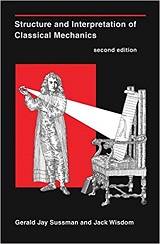
|
FreeComputerBooks.com
Links to Free Computer, Mathematics, Technical Books all over the World
|
|
- Title: Structure and Interpretation of Classical Mechanics
- Author(s) Gerald Jay Sussman (Author), Jack Wisdom (Author)
- Publisher: The MIT Press (November 19, 2024); eBook (Creative Commons Licensed)
- License(s): Creative Commons License (CC)
- Hardcover: 578 pages
- eBook: HTML and PDF
- Language: English
- ISBN-10: 0262553457
- ISBN-13: 978-0262553452
- Share This:

|
The new edition of a classic text that concentrates on developing general methods for studying the behavior of classical systems, with extensive use of computation.
We now know that there is much more to classical mechanics than previously suspected. Derivations of the equations of motion, the focus of traditional presentations of mechanics, are just the beginning. This innovative textbook, now in its second edition, concentrates on developing general methods for studying the behavior of classical systems, whether or not they have a symbolic solution.
It focuses on the phenomenon of motion and makes extensive use of computer simulation in its explorations of the topic. It weaves recent discoveries in nonlinear dynamics throughout the text, rather than presenting them as an afterthought. Explorations of phenomena such as the transition to chaos, nonlinear resonances, and resonance overlap to help the student develop appropriate analytic tools for understanding.
The book uses computation to constrain notation, to capture and formalize methods, and for simulation and symbolic analysis. The requirement that the computer be able to interpret any expression provides the student with strict and immediate feedback about whether an expression is correctly formulated.
This second edition has been updated throughout, with revisions that reflect insights gained by the authors from using the text every year at MIT. In addition, because of substantial software improvements, this edition provides algebraic proofs of more generality than those in the previous edition; this improvement permeates the new edition.
About the Authors- Gerald Jay Sussman is Panasonic Professor of Electrical Engineering at MIT.
- Jack Wisdom is Professor of Planetary Science at MIT.
- Physics, Computational Physics, and Mathematical Physics
- Calculus and Mathematical Analysis (Real Analysis, Functional Analysis, etc.)
- Computational and Algorithmic Mathematics

- Structure and Interpretation of Classical Mechanics (Gerald Jay Sussman, et al)
- The Mirror Site (1) - PDF
- The Mirror Site (2) - PDF, ePub, etc.
-
 Principles of Mechanics: Fundamental University Physics
Principles of Mechanics: Fundamental University Physics
This textbook takes the reader step-by-step through the concepts of mechanics in a clear and detailed manner. Many proofs and examples are included to help the reader grasp the fundamentals fully, paving the way to deal with more advanced topics.
-
 Variational Principles in Classical Mechanics (Douglas Cline)
Variational Principles in Classical Mechanics (Douglas Cline)
This book introduces variational principles and their application to classical mechanics. The relative merits of the intuitive Newtonian vectorial formulation, and the more powerful variational formulations are compared.
-
 Lecture Notes on Classical Mechanics (Sunil Golwala)
Lecture Notes on Classical Mechanics (Sunil Golwala)
You will learn a variety of new techniques and formalism that will allow you to attack a wider set of problems than you saw in the introductory sequences, more unified understanding of the structure and fundamental principles of classical physics.
-
 The Feynman Lectures on Physics (Richard P. Feynman, et al.)
The Feynman Lectures on Physics (Richard P. Feynman, et al.)
Ranging from the most basic principles of Newtonian physics through such formidable theories as general relativity and quantum mechanics, Feynman's lectures stand as a monument of clear exposition and deep insight.
-
 The Physics of Quantum Mechanics (James Binney, et al.)
The Physics of Quantum Mechanics (James Binney, et al.)
This book aims to give students a good understanding of how quantum mechanics describes the material world. It shows that the theory follows naturally from the use of probability amplitudes to derive probabilities.
-
 The Key to Newton's Dynamics (J. Bruce Brackenridge)
The Key to Newton's Dynamics (J. Bruce Brackenridge)
This book clearly explains the surprisingly simple analytical structure that underlies the determination of the force necessary to maintain ideal planetary motion, sets the problem in historical and conceptual perspective, showing the works of both Descartes and Galileo.
-
 Statistical Mechanics of Lattice Systems: Mathematical Introduction
Statistical Mechanics of Lattice Systems: Mathematical Introduction
This motivating textbook gives a friendly, rigorous introduction to fundamental concepts in equilibrium statistical mechanics, covering a selection of specific models, including the Curie–Weiss and Ising models, the Gaussian free field, etc.
-
 Relativity: The Special and General Theory (Albert Einstein)
Relativity: The Special and General Theory (Albert Einstein)
The great physicist himself disclaimed this exclusionary view, and in this book, he explains both theories in their simplest and most intelligible form for the layman not versed in the mathematical foundations of theoretical physics.
-
 An Advanced Course in General Relativity (Eric Poisson)
An Advanced Course in General Relativity (Eric Poisson)
Focusing on conceptual clarity, he derives all the basic results in the simplest way, taking care to explain the physical, philosophical and mathematical ideas at the heart of "the most beautiful of all scientific theories".
-
 Quantum Computing Since Democritus (Scott Aaronson)
Quantum Computing Since Democritus (Scott Aaronson)
This book takes readers on a tour through some of the deepest ideas of maths, computer science and physics. Full of insights, arguments and philosophical perspectives, the book covers an amazing array of topics.





